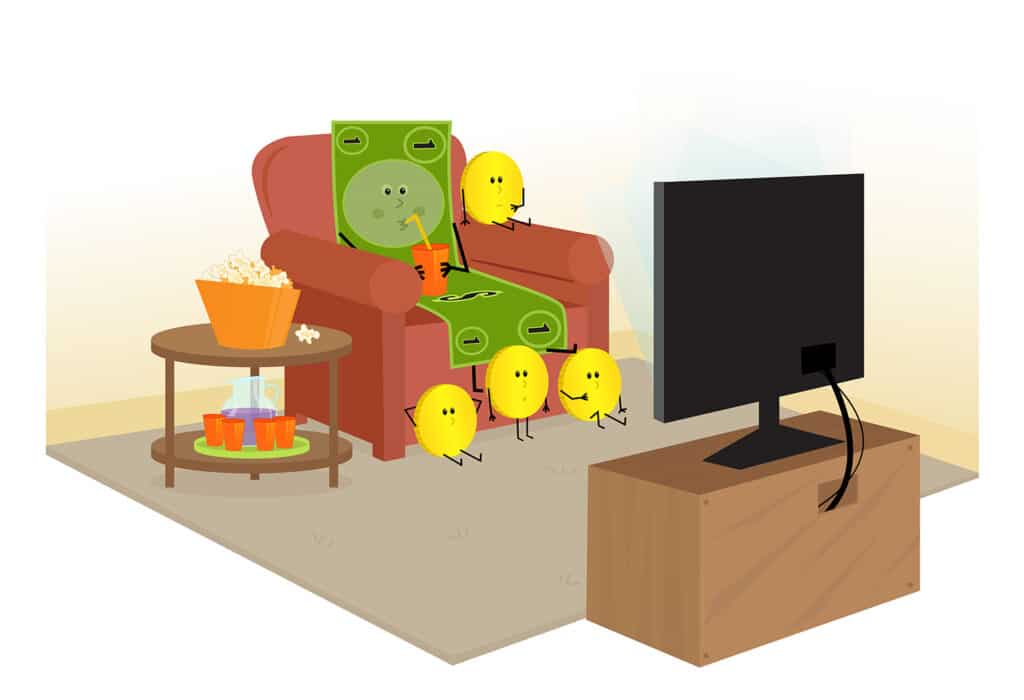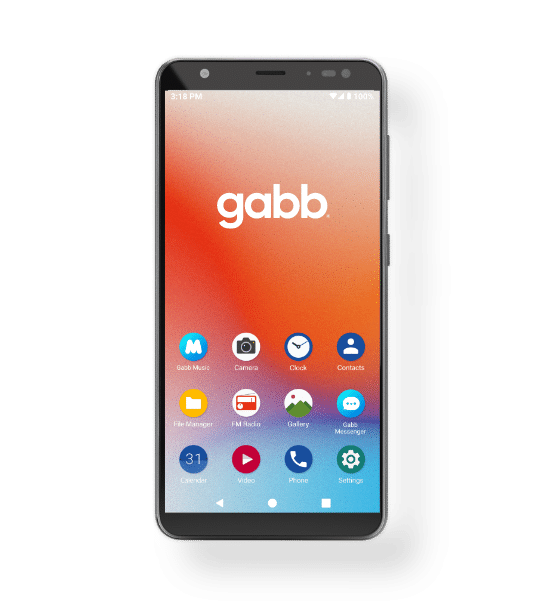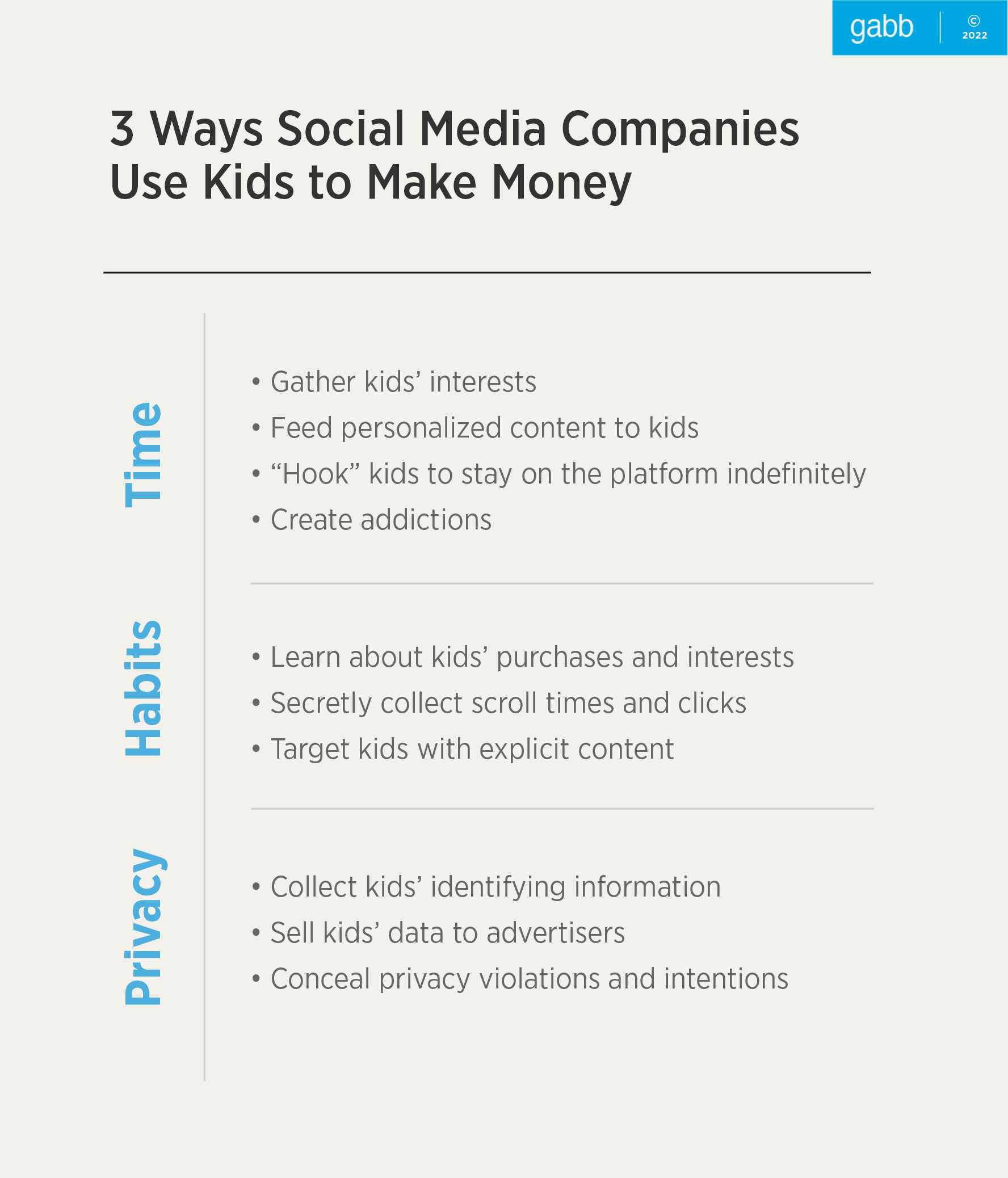How Social Media Companies Turn Kids Into a Product: The Cost of Social Media
Protect against social media exploitation
APR 27, 2022
How Social Media Companies Turn Kids Into a Product: The Cost of Social Media
Protect against social media exploitation
At a Glance
- Two ways social media companies make money
- How social media platforms “use your data”
- Teaching children about social media business models
All children need the adults in their life to understand the real dangers of social media to mental, emotional, and physical health.
Most social media companies actively exploit our kids by encouraging destructive habits, fostering screen addiction, and using their personal information for profit.
An investigative team of journalists from The Wall Street Journal tested TikTok’s algorithms by creating and automating “dozens of fake accounts registered as 13-year-olds.” These bots were programmed to explore teen interests and also to scroll through “For You” video feeds, just like a real child might do on the platform.
In lightening-quick response time, these platforms put videos into these feeds encouraging minors to view “endless spools of content about sex and drugs.”
Because TikTok can discover our kids’ “hidden interests and emotions” quickly and efficiently, they can be driven toward increasingly destructive content (Barry et al., 2021).
Clearly, social media can be used as a weapon against our kids and can pose a real threat to their mental, emotional, and physical well-being.
Social Media Tactics
Facebook, Instagram, Snapchat, TikTok, and other social media companies do not charge a fee for our families to be on their platforms, but if we think their services are free, we better take a closer look.
Our kids are paying with their activity on the platform, or as Investopedia suggests, by “renting [their] eyeballs” (McFarlane, 2021).
These companies pull in tens of billions of dollars per year by converting our children’s presence on their platform into cash (Johnston, 2022). They do this in two main ways.
Selling Advertising Space
Social media companies use our children’s presence on their platforms to make money by selling screen space to advertisers (McFarlane, 2021).
To better understand how this works, consider the analogy of a fisherman who wants to sell seafood at the fish market.

If the social media company is the fisherman, it’s tempting to imagine our children as shoppers—going to the fisherman to buy fish. But that isn’t really the case.
When kids visit social media sites, they do not pay a fee. Ironically, they’re actually the fish!
Social media companies turn our kids into products by luring our kids in with a free service.
Once they have caught them, they take our kids to the marketplace and track how often they pause, when they click, and their scroll speed.
This information is incredibly valuable to companies. Advertisers are eager to collect information about our children’s habits, so they purchase advertising space next to the content kids are looking at.
Social media corporations make big bucks from this model, and as parents and caregivers, we are the only ones who can protect our children.
Gathering and Selling User Data
Social media companies also monetize our kid’s presence on their platforms by gathering data about them.
Researchers from Loyola University explain how this process works, “Data can be collected from the things you post, like, accept, or search about through your devices. Big data companies and scientists then collect this data and build personas about you that can determine your age and gender, what you like, and much more” (Wake, 2017).
In the end, they can know things about our families that we may not have realized even about ourselves.
Data can be collected from the things kids post, like, accept, or search through [their] devices.
When talking about digital media companies, user data really means that they ‘use your data’.
These companies collect data about families to promote their businesses and charge advertisers more.
This works in three ways (Leetaru, 2018; 5 Rights Foundation, 2021, p. 21).
Keeping us on the platform longer
By gathering children’s data, they can feed our kids more of what they like so that they stay on the platform longer. The longer our kids stay on, the larger and more valuable fish they become.
Social media companies get more ‘eyeball renting time’ out of our kids, which translates to more money for the company.
Sending us more personal ads
By gathering our data, social media companies can learn a lot about our kids—their spending habits, things they want to buy, things they are interested in, etc.
Companies are then able to send families personalized ads we are more likely to click on.
The platform can tell these companies how long we slow down our scroll and if we click on their ad. This takes the guesswork out of advertising.
Marketers are willing to pay more for ad space on platforms that do this because they don’t have to hope the right people will come across their advertisements. They’re guaranteed to connect with their target audience every time.

Selling our data
By gathering our data, these media giants can literally box up our data and sell it to others.
Since this is considered an invasion of privacy, most companies go to great lengths to show they don’t do this.
They say things like, “We only share your data with our affiliates,” but they leave out that their affiliates are advertising agencies who are paying a premium for our data.
What Does This Mean for Kids?
Social media companies don’t differentiate their business model based on the user’s age—if they do it to adults, they do it to kids.
Snapchat, Instagram, and other social media giants sell our kids’ attention, data, and time for profit.
TV networks, billboard companies, newspapers, movie theaters, and other everyday parts of our lives follow the same business model (McFarlane, 2021).
If it keeps children safe, this isn’t a bad practice, but when they prioritize profits over people by encouraging excessive screen time—something social media companies do—this damages the health and wellbeing of young people (Office of the Surgeon General, 2021, p. 25).
Since social media companies make more money the longer we use their platforms, they have an incentive to make it hard for us to step away (5 Rights Foundation, 2021, p. 24).
We can waste hours watching cat videos when there are more necessary tasks and worthwhile relationships we could focus on. And as the Wall Street Journal discovered, companies will expose young users to explicit content, regardless of their age.
For kids, the scrolling and clicking increase exposure to predators, who lurk in social media spaces looking for prey.
Social media companies make more money the longer kids stay on their platforms; they have an incentive to make it hard for all of us to step away.
Feedback Loops Keep Us Scrolling
A feedback loop is a system where the output is returned as an input. It can become dangerous when the output is negative and results in a downward spiral.
For instance, many kids turn to social media when they are sad or lonely.
But if social media makes them feel depressed, they will find themselves in a negative feedback loop.
As a result, they will spend even more time on social media and less time with people, which can make them increasingly depressed.
Social media platforms have used feedback loops as a way to keep teens on their apps. A former Instagram executive leaked several internal research documents that showed the company knew its app caused girls to develop negative body image, but chose not to change its practices to maximize user engagement and profit (Clayton, 2021).
How Safe Devices Can Help
Since social media use becomes problematic in excess, kids who have it on their phones are most at risk.
Safe devices—phones without internet browsing or social media apps—are powerful tools that can teach our children moderation. Safe devices allow families the time to teach Tech in Steps™ where parents can model healthy habits and show kids the pitfalls.
They can help kids free themselves and live life beyond the screen.

How to Talk to Kids About Social Media
We don’t have to burn laptops or toss phones into the sea. This authoritarian approach can lead to other problems, such as diminishing their trust in us (Larzelere et al., 2013, p. 90).
Instead, we can open a dialogue that focuses on awareness and communication.
Just listen
As with any conversation with kids, it’s important to listen to what they have to share. Find out from them what it’s like to grow up in the digital age.
Some young people are likely already aware of the dangers and costs of using social media to some degree. Others may not see excessive screen time as harmful.
Be authentic
Having these conversations is the most important first step. If we are willing to share our own stories of problematic smartphone use, we will have a chance to bond and commiserate together.
We can most effectively approach this problem as a team. Once kids know we’ve heard them, we can show them how social media apps make money.
We can let them know that as caregivers, we don’t feel good about how they are being used.
Children are most likely to make healthy tech decisions when they feel informed, supported, and loved (Rinaldi, 2012, p. 271).
Explaining to Kids How Social Media Turns Them Into a Product
Here are some ideas to begin an ongoing conversation:
- What are some of your favorite digital media platforms? (TikTok, Google, Gmail, Snapchat, Reddit, Instagram, Discord,
MarcoPolo, LinkedIn, GoodReads, Tumblr, Facebook, etc.) Have you ever considered how they make money?
- Have you heard the phrase, “If a service is free, you are the product”? What does that mean to you?
- Do you think it’s fair of them to do this? Why or why not?
- If a social media company makes money every time we use their platform, they’ll want to keep us on their app as long as
possible. How often are you sucked in? I’ll tell you how they get me to keep scrolling.
- When I scroll for too long, I don’t feel good. How does scrolling endlessly make you feel?
- What can we do to protect ourselves mentally, physically, and emotionally?
- I know we can form healthy habits, especially if we make a plan together and check-in with each other.













Success!
Your comment has been submitted for review! We will notify you when it has been approved and posted!
Thank you!